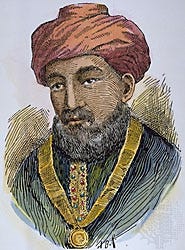“Holy Scripture only ever returns true judgments,” is something my students hear from me a lot–especially those in my current course on Maimonides and reading holy Scripture.
It’s a calculated phrase, working in both directions.
On the one hand, it alerts to the unique nature of holy Scripture in relation to truth and our judgments. Yes it’s true that technically speaking, holy Scripture is “never gonna steer you wrong.” And this, to state the obvious, is extremely important.
But on the other hand, it also puts distance between the concrete letters on the page which present themselves before our eyes, and the land of judgments in our intellect wherein truth and falsity lies. That distance is very long, and the process of “harvesting” a judgment from the letters of holy Scripture is quite fraught.
And this is one place where e.g., debates about inerrancy, issues of “literal” interpretation, and so on have not served people well (to say the least) in interpreting holy Scripture, by which I mean apprehending from the letters the true judgments which the prophets and apostles assented to. Such interpretation, of course, is the goal and where we might say communication of supernatural revelation has actually happened, namely, when we too assent to the true judgments–especially those which involve supernatural truths, which cannot be assented to otherwise than from divine testimonies.
But again I underline that the distance between letters and judgments is quite long, and a number of problematizing factors renders the process of “harvesting” judgments very fraught. Especially two of these factors have been on my mind lately as I have been working (and teaching) on Maimonides, and also studying Abelard (who, come to find, is a great companion to Maimonides on these issues). The first factor is that much of holy Scripture aims to deposit phantasms (“images”); and the second is that there are plenty of cases where the scriptural letters signify false judgments.
Difficulty 1: Images
First is the fact that much of holy Scripture aims to produce images, instead of, say, immediately inducing judgments. Aristotelians like to say that knowledge is taken from sense; but we could also rephrase this and say that phantasms are how knowledge begins and ends: we are human, after all. Holy Scripture gives us a multitude of images upon images which effects in us a state of being which is conducive to knowing, loving, and acting. Focusing on the first of these three, from these phantasm we can and do abstract judgments and true ones–but very often those judgments are very different than what the letters are “talking about.” Holy Scripture primes us for future knowledge-producing activities by constructing in us an initial databank, which can only very dimly be called “true”: truth is found properly in judgments, causally in realities, and (I suppose?) causally in phantasms.
Difficulty 2: Falsehoods
Second is the fact that some of holy Scriptures’ sayings signify in fact false judgments. Stick with me here, as this problem becomes difficult
Keep reading with a 7-day free trial
Subscribe to Quodlibeta Theologica to keep reading this post and get 7 days of free access to the full post archives.




